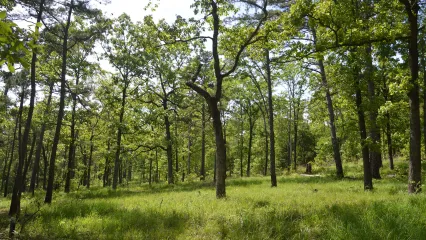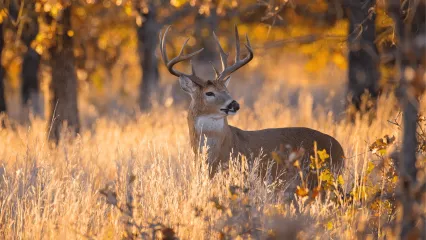
The McCurtain County Wilderness Area (MCWA) covers approximately 14,000 acres in northern McCurtain County. Located adjacent to the Broken Bow Reservoir and the Ouachita National Forest (north and east of the town of Broken Bow), the MCWA is the oldest Oklahoma Wildlife Department area and is the largest virgin, Shortleaf pine/hardwood forest remaining in the nation. Some riparian forest, consisting of hardwoods, such as sweet and black gums, red maple and elms occur along stream courses. The rugged terrain of the MCWA with its virgin forests and the adjacent reservoir offer some of the most beautiful scenery in the state. The average annual precipitation for the area is about 45 inches.
This area is open only to controlled deer and turkey hunts.
From Broken Bow: 21 miles north on U.S. Hwy 259, 7 miles east on gravel road at the highway sign (which is 3 miles south of the junction of U.S. Hwy 259 and Bethel Rd), follow the signs to headquarters.
- Deer: White-tailed deer are present in fair numbers.
- Turkey: Eastern wild turkeys are present in fair numbers.
- Rabbit: Both cottontail and swamp rabbits are found in low numbers.
- Furbearers: Coyote, bobcat, raccoon are present.
- Waterfowl: Migrating waterfowl and resident wood ducks occur infrequently on the reservoir.
- Red-cockaded Woodpecker: A small population of RCW’s ( the last known in Oklahoma) are found on the area.
- Bald Eagle: Eagles routinely winter on the Broken Bow Reservoir and Mountain Fork River.
Management efforts on the area are focused on restoring the pine/bluestem ecosystem and recovering the endangered Red-cockaded Woodpecker. Habitat improvements for the species consist of hardwood thinning and controlled burning on a three year rotation. The resulting open pine/hardwood forest also provides excellent habitat for game animals such as deer, turkey, and quail and a variety of nongame birds.
No developed facilities are on the area. Hiking and backpacking permits for the area east of the reservoir may be secured by contacting the area’s biologist at least two weeks before the arrival date. The hiking trail and boat ramp on the west side are open to public use. Members of the public who utilize the west side of the area must have at least one of the following: a valid Oklahoma Fishing License, Oklahoma Hunting License, or an Annual Wildlife Conservation Passport.
Fishing opportunities are excellent on the Reservoir and in the Mountain Fork River. No fishing is allowed on the streams within the wilderness.
All hunting seasons are closed except controlled deer and turkey hunts.
The self-guided nature trail is open year-round.
No public entry, except by persons possessing prior written permission from the Director of the Department or his designated representatives; Department employees; or by the Oklahoma Board of Agriculture, Division of Forestry personnel engaged in fire protection or suppression activities.
No camping allowed, except by permit.
McCurtain County Wilderness Area brochure
Kiamichi Country Tourism
1-800-722-8180
Oklahoma Tourism and Recreation Department
Post Office Box 52002
Oklahoma City, OK 73152-2002
(800) 652-6552 or (405) 521-2409
www.travelok.com
Talihina Chamber of Commerce and Ouachita National Forest Interpretive Association
900 Second St, Suite 12, Dept 03,
Talihina, OK 74571
(918) 567-3434
www.talihinacc.com
vera@talihinacc.com
Controlled Hunts: Yet More Ways to Up Your Odds
Additional features continue to be added to the Wildlife Department’s controlled hunts program.
Cackling Geese Tracked in Central Flyway Study
Researchers are tracking cackling geese wintering in a five-state study area to learn more about their movements and habitat preferences.
Study Focused on Bats and Disease-causing Fungus
Bat surveys were conducted to learn more about Oklahoma’s bat communities and hundreds of bats were swabbed for the fungus that causes white-nose syndrome.




